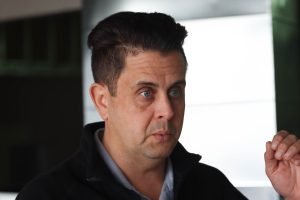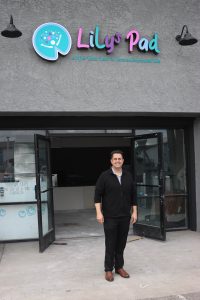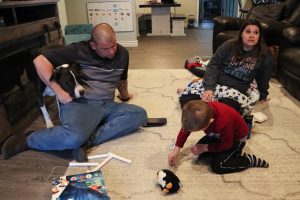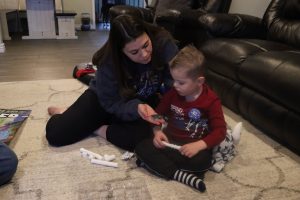- Slug: BC-CNS-Immunocompromised Playground. 1,310 words.
- 6 photos available (thumbnails and captions below).
Madison Vega
Cronkite News
PHOENIX – Colton Buckrucker giggles. He and his dad are building an air gun together as their three dogs jump around and bark, wanting in on the fun.
His mother, Christine Buckrucker, looks on. Their compact family circle is on her mind. Colton’s immune system is fragile, limiting the time he can spend with family, friends and classmates.
“Unfortunately, being immunodeficient is also really lonely,” Christine Buckrucker said. “It is very hard for our friends and family to understand.”
Common colds and other viruses can put Colton in danger. As an infant, doctors diagnosed him with transient hypogammaglobulinemia of infancy, an immune deficiency which can lead to frequent infections. The 4-year old has undergone at least three major surgeries and several other medical procedures in his short life.
The family of another immunocompromised child are working on Lily’s Pad, an indoor playground expected to open in April in Tempe for children like Colton, a safe environment where kids can be kids – scramble over playground equipment, learn how to play well with others, get stronger physically and emotionally. The Tempe playground, which will be free to families, will be added to other recreational areas in Arizona and elsewhere specifically for children with physical, intellectual or emotional disabilities.
The Buckruckers believe Colton’s world will expand.
“Putting him there is absolutely a relief because everybody there has the same concerns we do,” Christine Buckrucker said.
Building Lily’s Pad so immune-deficient children can play
Brad Taylor, the founder of Lily’s Pad, understands. His daughter, Lily, was 3 when she was diagnosed with leukemia, a little over five years ago. During her chemotherapy treatment, she just wanted to go to a park or another place to play. She only had two places medical experts said were safe for a child with a compromised immune system – her bedroom and her hospital room.
“She broke down into tears, just frustrated she could not go anywhere or could not see anybody,” Taylor said. He also noticed the isolation took its toll in other ways. “She was losing some social skills.”
The idea for Lily’s Pad was born to reduce those limitations.
Building health screenings, hospital-grade air systems for safety
At Lily’s Pad, kids with weakened immune systems will clamber over an indoor landscape similar to a park, including several slides, a climber and “some other interactive items,” said Executive Director Dawn Garza. More equipment might come later, depending on the budget.
Garza, who is Taylor’s sister, said a $100,000 Fiesta Bowl grant helped to finance the playground, with the facility and operations also bolstered by donations and partnerships with other organizations, such as Architekton, Phoenix Realtors and Knockout Plumbing.
The indoor playground is set up to allow 12 children to play at a time in the 5,200-square-foot facility that includes a quiet room, a “stage area” and even a space where parents can get advice or counseling on how to deal with the stress of having an immunocompromised child.
“We have partnerships with other nonprofits like Amanda Hope Rainbow Angels, and they’ll provide more mentoring, play therapy and other counseling opportunities for the families while the kids are at play,” Garza said.
Garza said they wrote detailed protocols for families, including a health screening and temperature checks. “As a community of immunocompromised children, we will expect families to be honest and careful to protect one another,” Garza said.
The playground equipment will be cleaned before and after each of the four daily sessions.
Garza worked with Debra Harris, a researcher and professor at Baylor University who specializes in human sciences and design, to equip the playground with the right health systems.
Harris talked about how she worked closely with Garza and the architect “to make sure that they get the best facility they can have to keep a safe environment for children,” but tried not to overstep.
A central feature of the playground that Harris worked on isn’t visible, the air system. The air will be filtered many times per hour in the hospital-grade HVAC system.
“It strains out more particulates and pathogens and some chemicals from the air so it does not get circulated into the facility,” Harris said of the HEPA filtration system.
The playground also will be considered as an experiment, with Harris working to determine whether it could become a model for others in the country.
“We have done a good job to design and build, now all we can do really is monitor it and make sure that it is meeting the expectations,” Harris said.
She calls it “surveillance.”
“We’re talking about putting in sensors in the facility that would be collecting data, all the time, in real time, that you can download from the cloud,” Harris said, adding the data would test the air quality.
Building inclusivity into recreational spaces
The Centers for Disease Control and Prevention estimates 2.6% of kids are considered immunocompromised, a broad term also known as immune deficiency or a weakened immune system. The share of children with any physical, mental or intellectual disability was 4.3% by 2019, according to the Census.
In recent years, inclusive parks, playgrounds and other recreational spaces for adults and children – public and privately owned – have emerged in Arizona, New Jersey and elsewhere in the U.S.
Build Jake’s Place has two outdoor parks in New Jersey designed as “playgrounds for everybody,” according to its website. Sensory walls for people with autism and cushioned, synthetic surfaces to accommodate wheelchairs provide an array of recreational areas for people with physical, intellectual and mental disabilities.
Executive Director Arthur Aston, who has spina bifida and uses leg braces, crutches and wheelchairs, said he understands the need for inclusive play areas.
“I truly know from a personal perspective of what it is like to not be a part of things and to be left out of things,” Aston said.
He said advocates for the organization have also spurred accessibility changes at other parks, such as double-wide ramps so people can use wheelchairs side by side. And Aston said a state law, Jake’s Law, requires every township in New Jersey to build at least one inclusive park.
In Phoenix, the Telephone Pioneers of America Park, completed more than two decades ago, is an “all children” accessible playground,’ according to phoenix.gov. The park has a therapeutic heated pool and a wheelchair-accessible playground, among other things.
And in Tucson, We Rock the Spectrum Kids Gym provides, for a fee, a “sensory-safe” experience, according to its website.
Building toward play on the horizon
Colton’s play nowadays centers around his family and preschool a few days a week. Colton is able to go to parks and school but he and his family have to be careful who they are around.
“If another child has even a runny nose or a cough we have to leave,” Christine Buckrucker said.
Once a week, he’s taken for his weekly injections, with a needle poked into each thigh. His injections are to bolster his immune system. He’s also autistic, which makes him a “complex care kid,” according to Christine Buckrucker.
“Without his infusions, he would not be at a school or be social in any way. We would not be able to have him in therapies to support the autism,” she said.
The injections don’t fix matters but do lessen the impact for Colton.
“Which is all we can ask for at this point, we know he is going to get sick but at least he will not be in the ICU,” Christine Buckrucker said.
She’s happy that Lily’s Pad not only will offer a place for Colton to play but will provide a built-in support system for parents who share similar struggles.
There’s “emotional trauma that comes with all of this,” Buckrucker said.
The playground, she said, will build a community of families.





